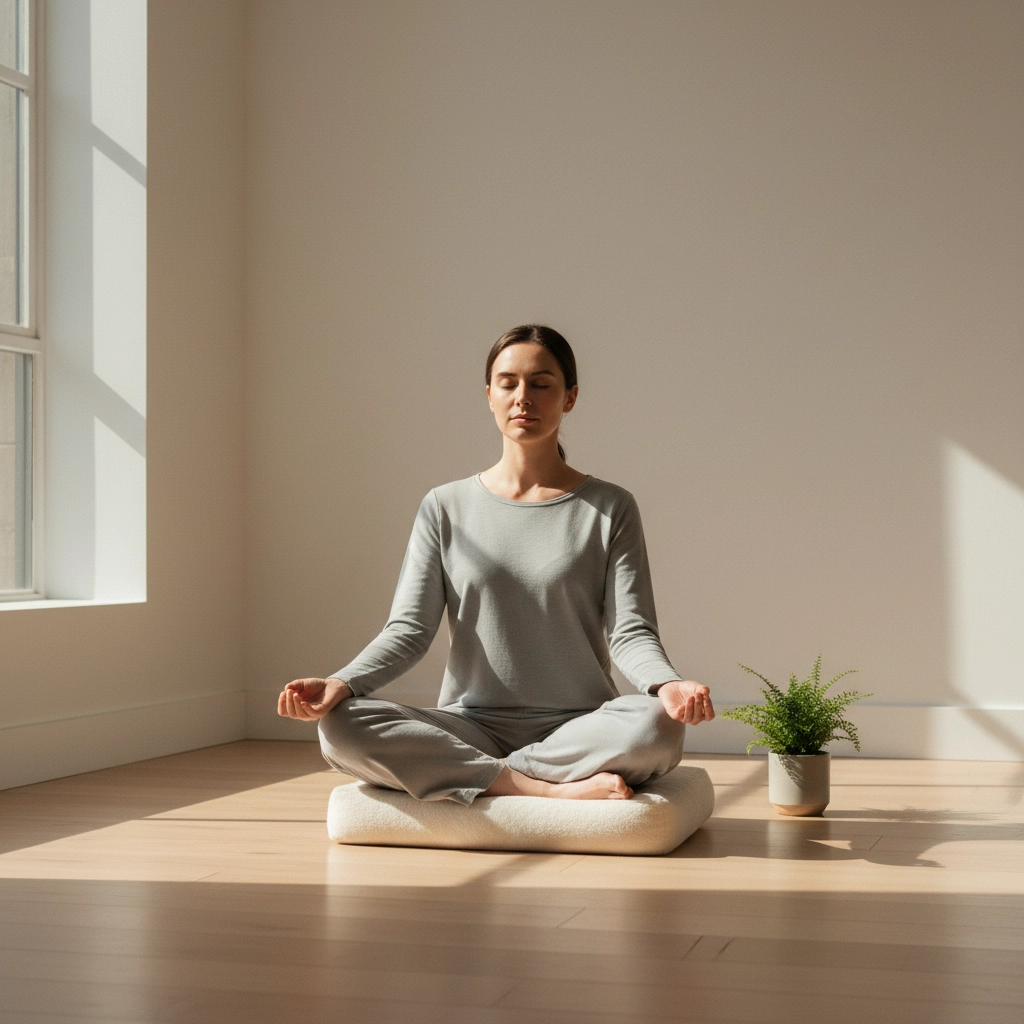Easy Ways to Start Meditating for Stress Relief
- Travis Moore
- Sep 8
- 5 min read
Stress has become an unavoidable part of modern life, but meditation offers a scientifically-backed solution that requires no special equipment or extensive training. By dedicating just a few minutes each day to simple meditation practices, you can significantly reduce stress levels and improve your overall well-being. The key lies in understanding that meditation doesn't require years of practice to be effective: even beginners can experience immediate benefits.
Research consistently shows that meditation activates the body's relaxation response, lowering stress hormones like cortisol while increasing feel-good neurotransmitters. The best part is that you can start experiencing these benefits today, regardless of your experience level or available time.
Understanding the Basics of Meditation
Meditation is fundamentally about training your attention and awareness. When you meditate for stress relief, you're creating space between yourself and your stressful thoughts, allowing you to observe them without being overwhelmed by them. This mental distance is what makes meditation so powerful for managing stress.
The process begins with finding a quiet, comfortable place where you won't be disturbed. You can sit in a chair with your feet flat on the floor, sit cross-legged on a cushion, or even lie down if sitting is uncomfortable. The most important factor is maintaining a position that allows you to stay alert while being comfortable.
For beginners, starting with just 5-10 minutes of practice is ideal. Many people believe they need to meditate for extended periods to see benefits, but research shows that even short sessions can produce measurable stress reduction. As you become more comfortable with the practice, you can gradually extend your sessions.

Simple Breathing Techniques for Immediate Relief
Deep Breathing Meditation serves as the foundation for most stress-relief practices. Begin by taking five deep, audible breaths: inhaling through your nose and exhaling through your mouth. As you breathe in, focus on expanding your lungs and taking in fresh air. As you exhale, consciously release any tension or stress you're holding in your body.
After these initial deep breaths, allow your breathing to return to its natural rhythm. Simply observe each inhale and exhale without trying to change anything. When your mind begins to wander: which it will: gently guide your attention back to your breath without judging yourself.
Counted Breathing provides additional structure for those who find it difficult to focus on breath alone. Count each exhale from one to ten, then start over. If you lose count or reach a number higher than ten, simply begin again at one. This technique gives your mind a simple task that helps prevent it from getting caught up in stressful thoughts.
4-7-8 Breathing is particularly effective for acute stress relief. Inhale for four counts, hold your breath for seven counts, then exhale for eight counts. This technique activates your parasympathetic nervous system, which is responsible for the body's rest and relaxation response.
Body-Based Meditation Techniques
Body Scan Meditation helps you release physical tension that contributes to stress. Start at the top of your head and slowly move your attention down through your body, noticing any areas of tension or discomfort. You don't need to change anything you find: simply observe and acknowledge what you're feeling.
As you scan each body part, imagine breathing into that area. Visualize tension melting away with each exhale. Pay particular attention to common stress-holding areas like your shoulders, jaw, and stomach. This technique not only reduces physical tension but also helps quiet mental chatter by giving your mind something specific to focus on.
Progressive Muscle Relaxation combines body awareness with active tension release. Starting with your toes, deliberately tense each muscle group for 5-10 seconds, then release and notice the contrast between tension and relaxation. Work your way up through your entire body, ending with your facial muscles.

Sound-Based Approaches for Stress Relief
Mantra Meditation uses repetitive words or phrases to anchor your attention and crowd out stressful thoughts. You can use traditional mantras like "Om" or create personal phrases such as "I am calm" or "This too shall pass." Repeat your chosen mantra silently or aloud, allowing its rhythm to guide your breathing.
The power of mantra meditation lies in its ability to give your mind something positive to focus on instead of stress-inducing thoughts. When you notice your attention drifting to worries or anxieties, gently return to repeating your mantra.
Music Meditation works well for people who find silence distracting or uncomfortable. Choose instrumental music with a slow, steady rhythm: nature sounds, classical music, or specifically designed meditation tracks work well. Focus on the different instruments, melodies, or sounds, using the music as your meditation anchor.
This technique is particularly helpful if you suffer from tinnitus or live in a noisy environment. The key is to actively listen rather than letting the music become background noise.
Movement-Based Meditation
Walking Meditation offers an excellent alternative for people who struggle with sitting still. You can practice this technique anywhere: in your backyard, at a local park, or even in your hallway. The key is to walk much slower than your normal pace, focusing on each step and the sensation of your feet touching the ground.
Coordinate your breathing with your steps, perhaps taking three steps for each inhale and three steps for each exhale. When your mind wanders to stressful thoughts, gently redirect your attention to the physical sensations of walking.
Mindful Movement can include gentle stretching, yoga, or tai chi performed with full attention to the body's movements and sensations. The goal isn't to achieve perfect form but to use movement as a meditation anchor while releasing physical stress.

Creating Your Personal Practice
Consistency matters more than duration when establishing a meditation practice for stress relief. Choose a specific time each day for your practice, even if it's just five minutes. Many people find success with morning meditation, as it sets a calm tone for the entire day, while others prefer evening sessions to decompress from daily stress.
Create a dedicated space for meditation, even if it's just a specific chair or corner of a room. Having a designated space helps signal to your brain that it's time to shift into a calmer state of mind.
Keep a meditation journal to track your progress and notice patterns in your stress levels. Note which techniques work best for different types of stress, and don't hesitate to experiment with various approaches until you find what resonates with you.
Overcoming Common Challenges
New meditators often worry that they're "doing it wrong" when their minds wander frequently. Mind wandering is not a sign of failure: it's a normal part of the process. The meditation happens when you notice that your mind has wandered and gently guide it back to your chosen focus point.
Some people experience increased anxiety when they first start meditating. This often occurs because meditation makes you more aware of thoughts and sensations you've been avoiding. If this happens, try shorter sessions or movement-based techniques until you feel more comfortable with stillness.
Physical discomfort during meditation is common and manageable. Adjust your position as needed, use cushions or back support, or try walking meditation if sitting is problematic. The goal is to be comfortable enough to focus on your practice.
Building Long-Term Success
Start with realistic expectations and gradually build your practice. Meditation is a skill that develops over time, and even experienced practitioners have sessions where their minds feel particularly busy or restless. These challenging sessions are as valuable as the peaceful ones.
Consider using guided meditation apps or videos when you're starting out. Having an instructor's voice to follow can make the practice feel less intimidating and provide structure for your sessions.
Connect with others who meditate, whether through local groups, online communities, or meditation classes. Having support and sharing experiences with others can help maintain motivation and provide practical tips for overcoming challenges.
By incorporating these simple meditation techniques into your daily routine, you can develop a powerful tool for managing stress. Remember that the goal isn't to eliminate all stress but to change your relationship with it, creating space for calm even in challenging circumstances. Start with just a few minutes today, and allow your practice to grow naturally as you experience the stress-relief benefits firsthand.
Comments